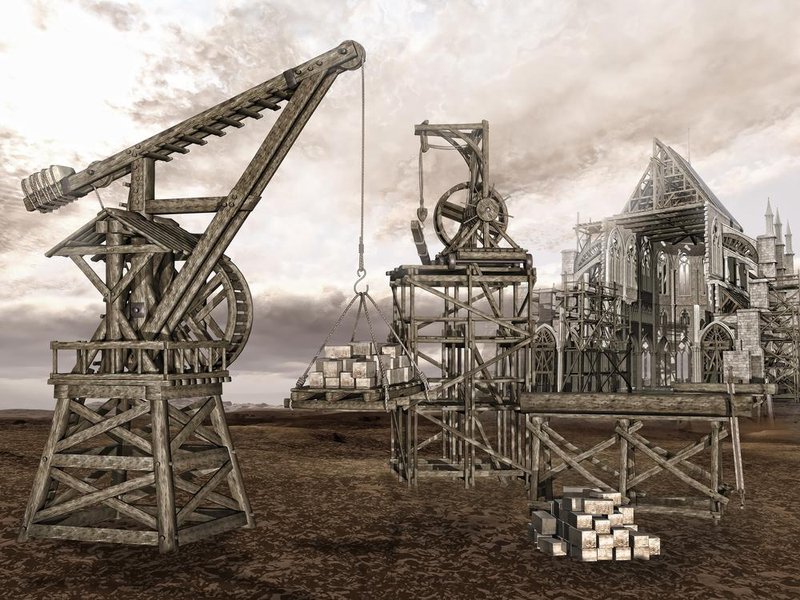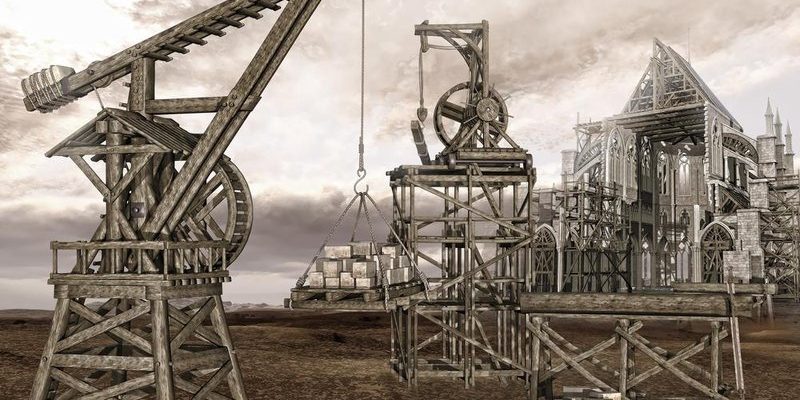
Imagine this: the very first cranes were simple machines invented by the ancient Greeks, designed to lift heavy objects with a combo of levers and pulleys. Fast forward a couple of centuries, and you find cranes transformed into complex structures powered by steam and electricity. That journey is fascinating, right? Let’s dive into the evolution and history of cranes—how they grew from rudimentary tools to the engineering marvels we depend on today.
The Origins of Cranes
Crane history dates back to ancient civilizations. The earliest known cranes were simple wooden devices, often crafted from timber and rope. The Greeks were the pioneers, using a system of pulleys and levers. Imagine a construction site in ancient Athens: workers hoisting blocks of stone to build the Parthenon—now that’s a sight.
Here’s a fun fact: the word “crane” likely comes from the similar-looking bird. Just like the graceful bird that stands tall and lifts its long neck, these machines were designed to reach high places. Think of them as the ancient construction workers’ way of expanding their reach.
As time moved on, the Romans saw the potential in cranes and improved upon them. They introduced cranes powered by human or animal labor. This transition was significant; it made lifting heavier materials more efficient and opened the door to larger construction projects.
The Industrial Revolution and Advancements
With the dawn of the Industrial Revolution in the 18th century, cranes underwent a major makeover. Suddenly, steam power came into play. This new power source allowed cranes to lift heavier loads and function at a much faster pace. Picture factories popping up everywhere, and you can bet there was a crane nearby, working tirelessly.
Steam-powered cranes came with their own set of complexities. Operators had to be diligent about maintenance and operation, but the payoff? Huge! These machines could lift bricks, iron, and other materials quickly and effectively. It was a game-changer for the building industry.
Electric cranes followed soon after, bringing about a new level of safety and efficiency. Imagine a construction worker not needing to rely solely on their physical strength; instead, they could operate these behemoths from a distance. This development set the stage for modern cranes.
Modern Cranes: Types and Uses
Fast forward to today, and cranes are as varied as they come. You’ll find tower cranes, which are often used in high-rise construction, standing tall like their ancient namesakes. Then there are mobile cranes, which are versatile and can move from one job site to another with ease. Each type of crane has unique features tailored for specific tasks.
To give you an idea, here are some common types of cranes:
- Tower Cranes: Ideal for tall buildings, these cranes offer high lifting capabilities.
- Mobile Cranes: Flexible and easily transportable, they’re used for various tasks.
- Crawler Cranes: With tracks instead of wheels, these can move over rugged terrain.
- Overhead Cranes: Common in factories, these cranes transport materials along a fixed path.
Each crane type caters to different needs, but they all share the common goal of making construction and heavy lifting easier. It’s fascinating how one invention has branched out to serve countless sectors, from construction to shipping.
Technological Innovations in Crane Design
As technology advanced, so did crane design. Today’s cranes are equipped with sophisticated features. For instance, many cranes now have computerized controls that enhance precision and safety. Imagine controlling a massive machine with just a few clicks—no more guesswork!
Also, modern power sources have taken cranes to the next level. Hybrid and fully electric cranes have emerged, significantly reducing environmental impact. Worksites are getting greener, and cranes are leading the charge. Honestly, it’s exciting to see how these machines are evolving to meet today’s demands.
Safety advancements have also played a huge role. Today, cranes come with safety features like load limiters and anti-collision systems. This ensures that while these powerful machines are at work, everyone around them stays safe.
The Role of Cranes in Urban Development
Cranes are not just tools; they’re symbols of urban growth. When you see one in action, it’s often a sign of progress. From skyscrapers to bridges, cranes help shape our cities. Think about it: a crane on a construction site is often an indication that something new and incredible is coming to life.
Cranes have been pivotal in transforming cityscapes around the globe. Consider the iconic skyline of New York City; countless cranes were part of that process. They’ve lifted and placed materials that now stand as landmarks. Without cranes, many of the world’s greatest architectural feats wouldn’t have been possible.
Moreover, cranes play a significant role during emergencies. They help in disaster relief efforts, such as removing debris after natural disasters. Their versatility means they can be used in various scenarios, continually proving their worth.
Challenges and Future of Cranes
Despite their advancements, cranes face challenges. Working at great heights and handling heavy loads raises safety concerns, making training a crucial aspect. Operators must be well-trained and constantly aware of their surroundings. Here’s the thing: even small mistakes can lead to significant accidents.
Future innovations hold promise. Concepts like autonomous cranes and further automation in construction might revolutionize how we use these machines. Imagine a world where cranes could operate independently, thanks to AI technology—it could increase efficiency and safety on job sites.
Sustainability is another key area for future innovations. As we look ahead, the focus will likely be on reducing the carbon footprint of cranes. Companies are already working on solar-powered options and other eco-friendly technologies.
From simple wooden structures to complex modern machines, cranes have a rich and fascinating history. They’ve evolved dramatically while adapting to the needs of society. Today, they are crucial in urban development, construction, and disaster relief.
As we look towards the future, the evolution of cranes will continue. New technologies promise to improve safety, efficiency, and environmental impact. It’s incredible to think about how something as seemingly straightforward as a crane carries such a weight of history and possibility.
So, next time you see a crane, take a moment to appreciate its journey—from ancient Greece to the modern skyline. It’s not just a machine; it’s a testament to human ingenuity and progress.

